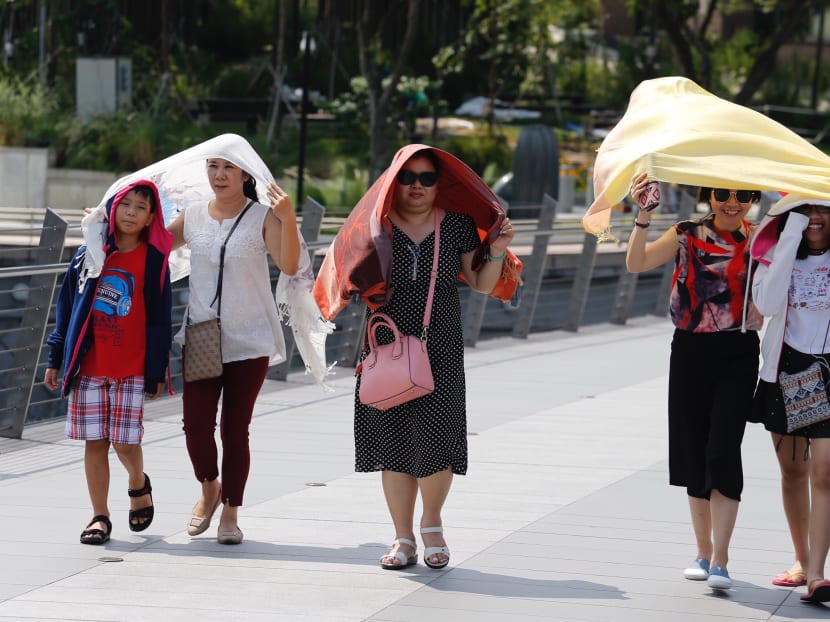Cool project underway: Singapore to develop road map to reduce urban warming
SINGAPORE — An “ambitious” project that began quietly at the start of this year could bring some relief to Singaporeans who have found themselves wilting in the heat of a concrete jungle.
SINGAPORE — An “ambitious” project that began quietly at the start of this year could bring some relief to Singaporeans who have found themselves wilting in the heat of a concrete jungle.
Temperatures are rising because of climate change, but Singapore is hotter than it should be because of the urban heat island (UHI) effect.
Cities tend to trap heat because of energy consumed, the presence of less vegetation and building materials that absorb and store heat from the sun.
In fact, the most urbanised areas here can be more than 7 degrees Celsius hotter than more rural parts at certain times of the day.
The project, called Cooling Singapore, aims to develop a road map for the Republic to reduce the UHI effect, said its lead principal investigator Peter Edwards.
The road map, consisting of long- and short-term measures, could be ready by the World Cities Summit next July, he said at an urban sustainability research congress last week.
“This is a matter important not just for Singapore but for all large cities, and Singapore could be the first city in the world to come up with a coherent strategy for tackling what is a very general problem,” said Professor Edwards.
Funded by the National Research Foundation, Cooling Singapore brings together researchers from the Singapore-ETH Centre, the Singapore-MIT Alliance for Research and Technology (Smart), TUM Create and the National University of Singapore.
The team has so far mapped Singapore’s energy flows. Hot off the press last week was the draft of strategies to mitigate UHI and improve the comfort felt outdoors by people. This will be refined into a combination of measures that would have an adequate impact.
“This isn’t just about putting the odd green roof in place. This is going to be ultimately a radical redesign of the city in terms of the shapes, the forms of the buildings, the building materials, transport systems and so on,” said Prof Edwards.
“And it’s not going to be done in five years. It’s the ... direction in which we must travel, otherwise the consequences of climate change, coupled with the growing UHI effect, will simply become intolerable.”
A UHI task force with representatives from multiple government agencies, such as the Housing and Development Board, the Land Transport Authority, the Building and Construction Authority and the National Parks Board, and universities has been set up.
The researchers will meet the task force on Monday (July 3), for a first workshop to discuss mitigation strategies.
The task force was one of Cooling Singapore’s goals because “we need to build a community within government which really understands the complexity of the UHI effect and can ... carry forward this ambitious project”, said Prof Edwards, an ecologist and director of the Singapore-ETH Centre.
The research project will conclude in about 18 months, “but we want a legacy of it to be a community that can really understand these issues and give them the priority they deserve”.
His team will also identify areas of research on UHI and develop tools to assess effects of the mitigation measures.
The 86 mitigation measures include: Green parking lots that trap less heat than the asphalt used traditionally, urban farms, variation in building heights, shaded bicycle lanes and well-ventilated pedestrian walkways.
Electric vehicles, with lower running temperatures than conventional ones and a lack of exhaust, would also help, as could smart shading devices using materials that can change colour, shape or density according to temperature, humidity or light.
Buildings should also be designed for heat from air-conditioning units to be released in well-ventilated areas.
Prof Edwards said that while no city has succeeded in cancelling the UHI effect, some measures such as green roofs, reflective materials and permeable pavements have been found to make quite a difference.
Active-mobility user Tham Chen Munn, who is not involved in the project, said roads and tarmac are a major contributor to heat, causing many people to feel that “it’s too hot to cross the road”. Mitigating this would require informed design and planning, he added.
Some road lanes can be narrowed to reduce the area of tarmac, suggested Mr Tham, a transport consultant: “This not only reduces heat, but streets will then be designed to be low-speed areas, which are meant to be safe for motorists, cyclists and pedestrians.”
Reduced lane widths could also create more space for cycling and pedestrian paths, which, with landscaping, would make them more comfortable for cyclists, pedestrians and e-scooter users, he added.
A study published this year in the journal Nature Climate Change found that the UHI effect could more than double the costs for cities to address global warming this century.










